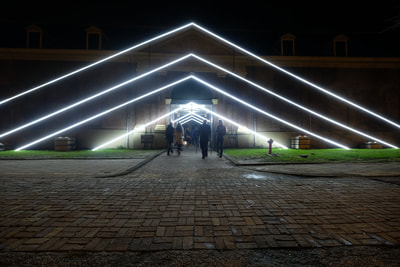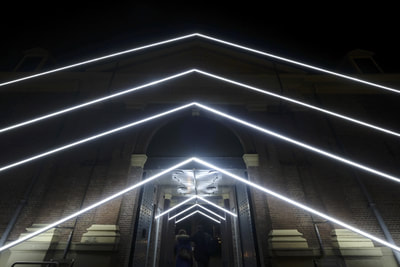Kattenburgerstraat 5
Amsterdam Light Festival, Marinetrerrein, Amsterdam 2017
LED light, aluminium profiles, steel. 40 x 12 x 8,5 m.
|
De enorme, lichtgevende driehoeken waaruit Vinks installatie Kattenburgerstraat 5 bestaat, wijzen je op een bijzonder element dat je vindt boven de 17e eeuwse poort in het gelijknamige marineterreingebouw: het eveneens driehoekige timpaan. In het timpaan is een reliëf van het wapen van de Amsterdamse Admiraliteit (de voorloper van de marine) verwerkt; eronder staan afbeeldingen van de scheepsbouw-gereedschappen. Die gereedschappen werden gebruikt door de mensen die op de scheepswerf werkten – in de hoogtijdagen zo’n 2000 – en het terrein via de poort binnengingen. Vink vraagt met zijn installatie dus niet alleen aandacht voor de vorm en de maatvoering in de poort zoals die ooit zijn bedacht door de architect, stadsbouwmeester Daniël Stalpaert (1615-1676), maar ook zijn oorspronkelijke functie en de geschiedenis die het symboliseert.
Vinks timpanen accentueren behalve de ingang van de poort, ook de onderdoorgang zelf. Wanneer je onder de poort doorloopt buigt de gehele ruimte zich naar je toe – net als tijd, ruimte en licht in ons universum dat kunnen doen. Einstein beschreef het in zijn beroemde algemene relativiteitstheorie: wanneer de ruimte en tijd krommen door de zwaartekracht van bijvoorbeeld een zwart gat of een planeet, buigt het massaloze licht mee. En zo transformeert een eeuwenoude, alledaagse gang met Vinks lichtmarkering tot een plek die misschien wel veel meer dan dat kan zijn. Tekst: Roos Hollander |
The enormous lines that make up Peter Vink’s installation Kattenburgerstraat 5 refer to the special tympanum that you will find above the 17th century entrance gate of the Marineterrein. The tympanum includes a relief of the arms of the navy’s forerunner, the Amsterdam Admiralty, as well as several depictions of shipbuilding tools that were used by the workers who entered the shipyard through this gate. With his installation, Vink therefore not only pays attention to the shape and dimensions of the gate as it was designed by city architect Daniel Stalpaert (1615-1676), but also to its original function and the history that it symbolises.
Vink's tympanums accentuate the entrance of the gate, including the underpass itself. As you walk under the gate, it is as though the whole space bends towards you - just like time, space and light in our universe do. Einstein described it in his famous theory of relativity: when space and time are curved by the gravity of, for example, a black hole or planet, the massless light bends with it. And so, Vink's light marking transform an age-old, everyday walk into a place that might be much more than that. Text: Roos Hollander |












